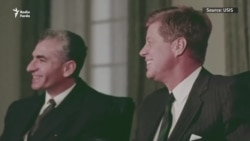John F. Kennedy was born on May 29, 1917, in Brookline, Massachusetts. A few months later, the October Revolution took place in Russia. No one could even imagine that newborn in Massachusetts would be elected the 35th president of the United States and challenge the Soviet Union during the years of the Cold War.
Kennedy graduated from Harvard University in 1940 and joined the U.S. Navy the following year. His service in the Navy coincided with World War II, when the great powers of the world were engaged in an epic global conflict. Kennedy was in the midst of that, and it had a great influence on him. Shortly after the war, when he was only 29, he was elected to the U.S. House of Representatives and later served three consecutive terms as senator. In September 1953, he married journalist Jacqueline (Jackie) Lee Bouvier (Jacqueline Kennedy).
When Kennedy was elected president, despite being the youngest president ever he carried a baggage of experience from the war and understood how to manage Cold War relations in the best interest of the United States.
U.S.-Iran relations under J.F.K. were strong and deeply rooted. However, the Shah was not quite determined to go through the democratic changes Kennedy expected.
Crises: During the short time J.F.K. was president, he had to handle several different crises, including Cuban Missile Crisis, which became the major nuclear standoff of the century. He also confronted the Soviets on the issue of the Berlin Wall.
Kennedy succeeded in getting a nuclear test ban treaty signed by UK Prime Minister Harold McMillan and Soviet leader Nikita Khrushchev in July 1963.
Kennedy and Iran: Understanding the strategic importance of the Middle East, Kennedy approached the Shah of Iran for closer cooperation and to stabilize Iran internally. In April 1962, the Shah of Iran was invited to the United States. He was warmly welcomed and visited several military sites and NASA headquarters in Cape Canaveral, Florida, as well as a U.S. Atlantic Navy base in North Carolina. The Shah’s visit to New York was a majestic show of respect and welcoming for a royal family. A 20-minute video at John F. Kennedy’s Presidential Library and Museum highlights the major instances of this visit.
Kennedy was eager to prevent a Soviet influence in Iran by creating a firm alliance; however, his plans were not completely followed through after his assassination. Kennedy and his administration were convinced Iran needed rapid economic improvement, literacy, and social mobility in order not to become a fertile ground for communist influence.
U.S.-Iran relations under J.F.K. were strong and deeply rooted. However, as was the case with some other leaders of the region, the Shah was not quite determined to go through the democratic changes Kennedy expected. There was also some uncertainty about the future of relations.
Kennedy’s tragic assassination on November 22, 1963, in Dallas, Texas, put an end to his initiatives regarding Iran and the world, but it also highlighted his life and personality as the most favored president in the history of the United States. Lee Harvey Oswald, who assassinated John F. Kennedy, was himself killed by another shooter, but his death left the puzzle of this assassination unsolved -- forever.





